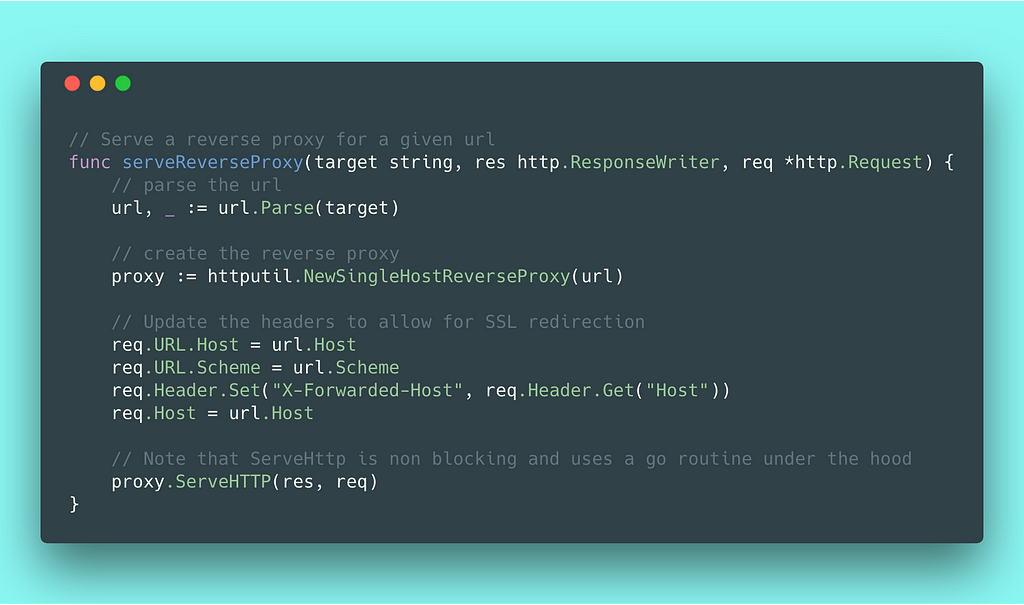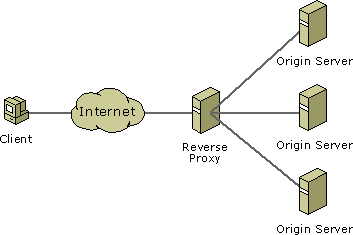Latest news about Bitcoin and all cryptocurrencies. Your daily crypto news habit.
Leave your programming language hang ups at the door and come admire the best standard library I’ve ever come across.
 This is all the code you actually require…
This is all the code you actually require…
Choosing a Programming Language for a project shouldn’t be like declaring who your favourite team is. it should be a matter of pragmatism and choosing the right tool for the right job.
In this post I want to show you when and why Go shines as a language. Specifically I want to show you how rock solid their standard lib is for basic internet programming. Even more specifically… were gonna write a Reverse Proxy!
“Go has a lot going for it but where it really struts it stuff is in these lower level network plumbing tasks, there’s no better language.”
What is a reverse proxy? A big fancy way of saying a traffic forwarder. I get a request send from a client, send that request to another server, receive a response from the server and forward it back to the client. The reverse part of this simply means the proxy itself determines where to send traffic and when
Why is it useful? Because the concept is so simple it can be applied to assist in many different cases: Load balancing, A/B Testing, Caching, Authentication etc…
By the end of this short post you will have learned how to:
- Serve HTTP requests
- Parse the body of a request
- Serve traffic to another server using a Reverse Proxy
Our Reverse Proxy Project
Lets dive into the actual project. What we are going to do is have a web server that:
1. Takes requests
2. Reads the body of a request, specifically the proxy_condition field
3. If the proxy domain is equal to A send traffic to URL 1
4. If the proxy domain is equal to B send traffic to URL 2
5. If the proxy domain is neither then send traffic to the Default URL.
Prerequisites
- Go for programming with.
- http-server for creating simple servers with.
Setting up our environment
First thing we want to do is input all the required configuration variables into our environment so that we can both use them in our application while keeping them out of source code.
I find the best approach is to create a .env file that contains the desired environment variables.
Below is what I have for this specific project:
After you save your .env file you can run:
source .env
to configure load the config into your environment any time.
Laying the foundation of our project
Next lets create a file called main.go that does the following:
1. When started logs the PORT, A_CONDITION_URL, B_CONDITION_URL, and DEFAULT_CONDITION_URL environment variables to the console
2. Listen for requests on the path: /
Now you should be able to run
Parse the request body
Now that we have the skeleton of our project together we want to start creating the logic that will handle parsing the request body. Start by updating handleRequestAndRedirect to parse the proxy_condition value from the request body.
Use proxy_condition to determine where we send traffic
Now that we have the value of the proxy_condition from the request we will use it to decide where we direct our reverse proxy to. Remember from earlier that we have three cases:
- If proxy_condition is equal to A then we send traffic to A_CONDITION_URL
- If proxy_condition is equal to B then we send traffic to B_CONDITION_URL
- Else send traffic to DEFAULT_CONDITION_URL
Reverse Proxy to that URL
Finally we are onto the actual reverse proxy! In so many languages a reverse proxy would require a lot of thought and a fair amount of code or at least having to import a sophisticated library.
However Golang’s standard library makes creating a reverse proxy so simple it’s almost unbelievable. Below is essentially the only line of code you need:
httputil.NewSingleHostReverseProxy(url).ServeHTTP(res, req)
Note that in the following code we add a little extra so it can fully support SSL redirection (though not necessary):
Start it all up
Ok now that we have this all wired up setup our application on port 1330 and our 3 simple servers on ports 1331–1333 (all in separate terminals):
- source .env && go install && $GOPATH/bin/reverse-proxy-demo
2. http-server -p 1331
3. http-server -p 1332
4. http-server -p 1333
With all these up and ruuning we can start to send through a requests with a json body in another terminal like so:
curl --request GET \
--url http://localhost:1330/ \
--header 'content-type: application/json' \
--data '{"proxy_condition": "a"
}'
If your looking for a great HTTP request client I cannot recommend Insomnia enough.
and Viola we can start to see our reverse proxy directing traffic to one of our 3 servers based on what we set in the proxy_condition field!
Wrap Up
Go has a lot going for it but where it really struts it stuff is in these lower level network “plumbing” tasks, there’s no better language. What we’ve written here is simple, performant, reliable and very much ready for use in production.
For simple services I can see myself reaching for Go again in the future.
🧞 This is open source! you can find it here on Github❤️ I only write about programming and remote work. If you follow me on Twitter I won’t waste your time.
Writing a Reverse Proxy in just one line with Go was originally published in Hacker Noon on Medium, where people are continuing the conversation by highlighting and responding to this story.
Disclaimer
The views and opinions expressed in this article are solely those of the authors and do not reflect the views of Bitcoin Insider. Every investment and trading move involves risk - this is especially true for cryptocurrencies given their volatility. We strongly advise our readers to conduct their own research when making a decision.

